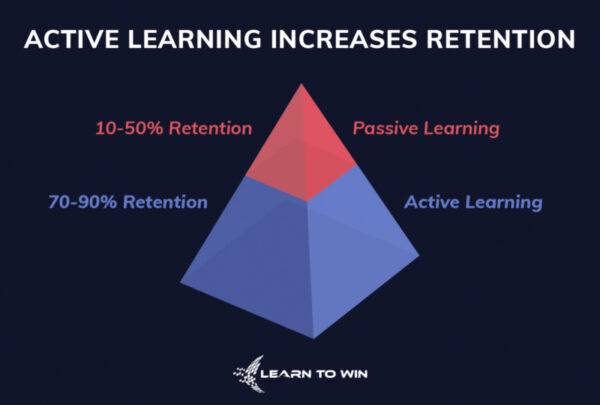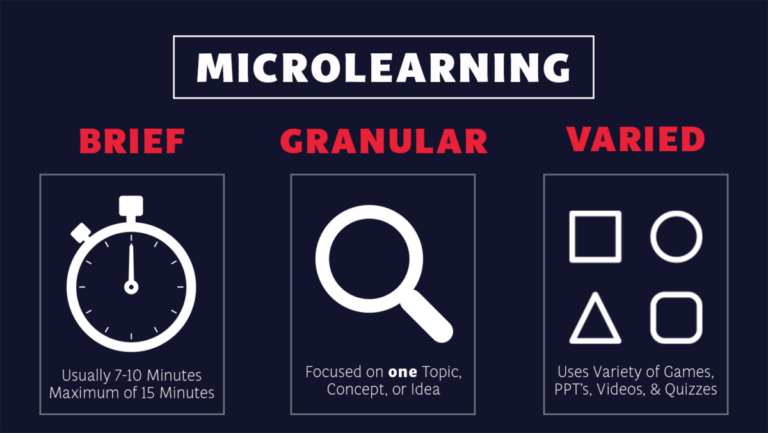Does your team struggle with learning and retaining information? There may be a better way to teach and learn, using the latest strategies in education technology and cognitive science.
Do your team members have trouble memorizing pages upon pages of training documents? Reading through pages of dense material or watching long video modules reduces your learner’s attention. Improving your teaching strategies may engage your learners and improve results.
Practice of Active Learning

Microlearning

Increasing Your Team’s Knowledge Retention

Spaced repetition: Newly introduced and more difficult topics are shown more frequently, while older and less difficult topics are shown less frequently, mixing different topics to blend knowledge from different areas. Older concepts are reinforced alongside newly introduced concepts, creating a total learning strategy. Learn more about spaced repetition here.
Spacing effect: Research shows that more information is encoded into long-term memory better through spaced study sessions than by “cramming,” or massed studying, such as in studying for an exam the night before.
Retrieval practice: The act of “calling information to mind rather than rereading it or hearing it.” Memories are encoded stronger when the learner recalls the information as opposed to learning it again.

Learn to Win ensures that leaders can establish ‘continuous readiness’ with the click of a button, reminding their learners of must-know information and receiving insightful reports of who may not be up-to-speed. It also forces content creators to break down their content into engaging slides, games, and learning tools that command attention and effort.
Structuring Lesson Plans
Use scaffolding and chunking to organize materials in a way students understand, then use effective quizzing strategies to test their comprehension.
- Scaffolding: Providing assistance to learners on an as-needed basis, decreasing assistance as the competence of the learner increases. a way to organize information that increases information storage capacity by grouping information into chunks.
- For example, teachers may provide hints and teaching points early in the lesson plan, but gradually remove those supports as the students continue mastering the concept or skill.
- Chunking: Using various media and text formats helps break up large chunks of text, making it easier for learners to read.
- Break information into pieces using short sections, lists, images, videos, and examples.
- Use headings and subheadings to guide readers through the information.
- Don’t try to fit too much information on one slide or page.
- Guide learners by using questions to reflect the goals of each lesson.
Quizzing Learners Effectively
Formative assessment (or “Low-Stakes Quizzing”) is a concept that describes assessments that carry no weight in terms of grades, rewards, punishments, or ranking.
The goal of low-stakes quizzing is to help learners self-assess and check for learning along their journey, but research shows that these quizzes serve an even greater purpose. Quizzes force students to practice the act of retrieval (accessing information learned previously). Every time a student practices the retrieval of information, the information is solidified in the student’s brain.
Low-stakes quizzes can take many forms, but their key element is that the learner feels safe to fail them, misunderstand them, question them, ask for help on them, and retake them again when they feel more confident with the content. Learn about building effective lessons and quizzes in our blog post.
Learn to Win provides easy-to-create low-stakes questions that can be integrated into any lesson to solidify a student’s knowledge and give them confidence in their progress.
Building Engaging Lessons
Mix up lesson content with quiz questions to reinforce callback in a low-stakes environment.
Re-use old questions to test and increase retention. Remember spaced repetition and the spacing effect, which show that bringing in old material increases long-term retention.
Try using scenario-based lessons to require the learner to think critically and apply their knowledge base.
- Scenario-based lessons also help with near skill transfer, which helps learners think on the spot and apply what they’ve learned to new situations.
- Athletics users might show players a formation and ask them to identify their assignment.
- Enterprise users might give learners a customer service scenario and ask them how they would respond.
Providing Learners with an Optimal Learning Environment
While learning is a fluid activity that humans practice continually, not all learning environments or conditions are ideal.
Education researchers have pinpointed a few factors that lead to heightened learning and improved outcomes. The most well-supported include:
- Novelty: Brains are drawn to novelty and lulled by monotony, meaning that a variety of learning tools/modalities are optimal for engaging learners.
- Flexible Learning Paths: Much of self-guided learning is non-linear, so learners need the freedom to chart their own learning journey in a ‘safe’, structured environment.
- Attention: Pathbreaking research by Michael Posner and Steven Peterson shows that there are three attention centers in the brain that help get the learner’s attention (alerting), keep them on task (sustaining), and help them determine what’s important (executive functioning).
- Memory: The speed and strength of recall is dependent on the working, short-term, and long-term memory operating in conjunction.
- Near Transfer Success: Most “brain building” activities fail to translate learning into similar, but not identical, contexts. Players, however, must identify assignments even when the opponent introduces a new formation or strategy. Learners must be able to take a concept learned in a lesson and apply it to a variety of real-world scenarios.
Learn to Win hard-codes novelty, self-driven learning, and memory and attention exercises to improve the success of “transfer” from the online platform to the field, court, or air.
How do sports programs use effective learning strategies to build lesson plans?
As technology has evolved, coaches must adapt to best reach their players.
Using digitized playbooks, players can learn material during gaps in their day by pulling out their smartphone to take short lessons based on microlearning principles.
By uploading material and tracking players’ retention, coaches can best use their practice time on the field. Rather than wasting time watching film, players have already studied film and plays before they come to practice.
Pairing efficient online learning with in-person training on the field means coaches can maximize their time and their player’s potential to prevent game-defining mental errors.
How do companies use effective learning strategies to build training programs?
How did companies train previously?
How can companies train better and more efficiently?
Business leaders have the opportunity to enhance their team’s performance by integrating effective learning strategies and mobile learning into their corporate training.
Use these learning upgrades to get started:
- Leverage bite-sized modules to easily and quickly onboard new employees.
- Allow employees to actively engage with scenario-based lessons to prevent dangerous and costly mistakes BEFORE they happen.
- Use spaced repetition and the spacing effect to enhance knowledge retention and ensure customer satisfaction with a team that’s prepared.
- Capitalize on quick and mobile-accessible micro-learning to provide a continuous learning experience for growth-oriented employees and to reduce turnover.
Ultimately, upgrading your training procedures with these effective learning strategies will keep your employees engaged, improve training efficiency, and reduce mistakes on the job.
Improve Your Organization’s Teaching and Learning with Learn to Win
Stay up-to-date with the latest strategies in teaching and learning to keep your learners engaged and learning smarter, not harder.
With the best practices in Ed Tech integrated into Learn to Win’s platform, you’ll improve your team’s learning outcomes in no time.
If you’re interested in learning more about Learn to Win’s online learning tools, click here to request a demo!

